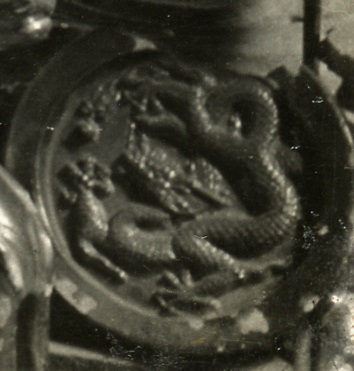Provenance: China, the Ming dynasty, the period of Emperor Yŏnglé (1402–1424) or Wànli (1572–1620).
Workshop: unknown, probably from the vicinity of Beijing (Beijing)
Architectural detail; burnt clay; die imprinting, manual processing, yellow or green glazing, multiple firing
Dimensions: unknown, probably 17.5–19 cm (data based on comparison with artifacts from the collection of the Museum für Ostasiatische Kunst in Cologne).
Signatures, inscriptions – none
Pre-war inv. No. – unknown
Date of loss of the work: 1945
Current place of storage, inv. – unknown
In the pre-war collection in Malbork there were several whole goutou and dishui roof tiles, probably donated by the Chinese prince regent Zaifeng and delivered to Malbork in 1908, as well as terracotta tiles from Ernst Börschmann. The goutou type corresponded to the European type of the monk tile, and the dishui type to the nun tile. Goutou was characterized by a round end, most often with a dragon motif. The dishui type had the shape of a three-leaf closed plate, also with the motif of a fantastic beast or flowers. The first time that such an architectural detail was produced under the Emperor Hóngwŭ (reign 1368–1398) at the imperial brickworks in Jubaoshan for the palace building under construction in Nanjing. This production developed on a larger scale during the reign of Emperor Yŏnglé (1402–1424) and continued until the 19th century.
The lost object is a ceramic, round end of a trough roof tile from the eaves section with a relief pattern of a dragon with a scaly skin and a snake’s torso, with five legs ended with five claws, with long hair, which dances with a pearl.
Iconography: the five dragon claws were the symbol of the emperor. The dragon with the pearl is the keeper of the jewels, and the pearl was the greatest treasure – the treasure of wisdom.
The yellow color of the tiles was attributed to imperial buildings. The yellow dragon symbolized the coming happiness (see Wolfram Eberhard).
(compiled by Dr. B. Pospieszna)

